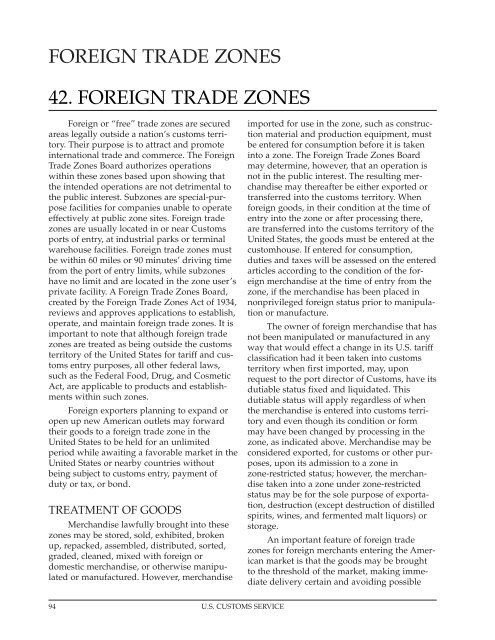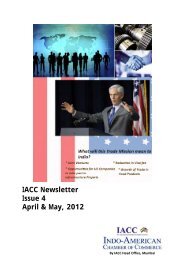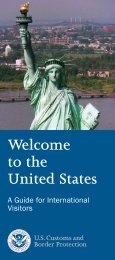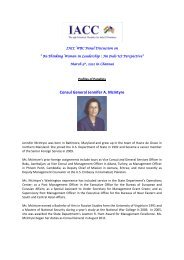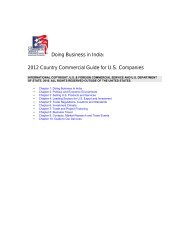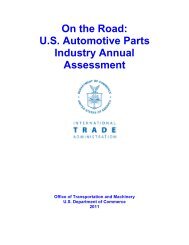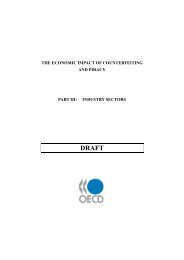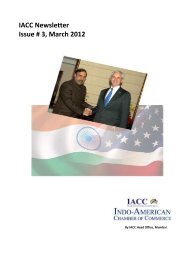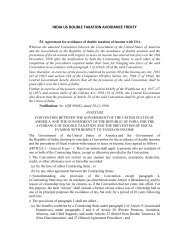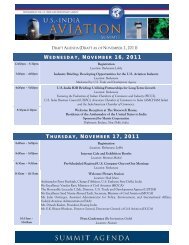Importing into the United States - Indo-American Chamber Of ...
Importing into the United States - Indo-American Chamber Of ...
Importing into the United States - Indo-American Chamber Of ...
You also want an ePaper? Increase the reach of your titles
YUMPU automatically turns print PDFs into web optimized ePapers that Google loves.
FOREIGN TRADE ZONES<br />
42. FOREIGN TRADE ZONES<br />
Foreign or “free” trade zones are secured<br />
areas legally outside a nation’s customs territory.<br />
Their purpose is to attract and promote<br />
international trade and commerce. The Foreign<br />
Trade Zones Board authorizes operations<br />
within <strong>the</strong>se zones based upon showing that<br />
<strong>the</strong> intended operations are not detrimental to<br />
<strong>the</strong> public interest. Subzones are special-purpose<br />
facilities for companies unable to operate<br />
effectively at public zone sites. Foreign trade<br />
zones are usually located in or near Customs<br />
ports of entry, at industrial parks or terminal<br />
warehouse facilities. Foreign trade zones must<br />
be within 60 miles or 90 minutes’ driving time<br />
from <strong>the</strong> port of entry limits, while subzones<br />
have no limit and are located in <strong>the</strong> zone user’s<br />
private facility. A Foreign Trade Zones Board,<br />
created by <strong>the</strong> Foreign Trade Zones Act of 1934,<br />
reviews and approves applications to establish,<br />
operate, and maintain foreign trade zones. It is<br />
important to note that although foreign trade<br />
zones are treated as being outside <strong>the</strong> customs<br />
territory of <strong>the</strong> <strong>United</strong> <strong>States</strong> for tariff and customs<br />
entry purposes, all o<strong>the</strong>r federal laws,<br />
such as <strong>the</strong> Federal Food, Drug, and Cosmetic<br />
Act, are applicable to products and establishments<br />
within such zones.<br />
Foreign exporters planning to expand or<br />
open up new <strong>American</strong> outlets may forward<br />
<strong>the</strong>ir goods to a foreign trade zone in <strong>the</strong><br />
<strong>United</strong> <strong>States</strong> to be held for an unlimited<br />
period while awaiting a favorable market in <strong>the</strong><br />
<strong>United</strong> <strong>States</strong> or nearby countries without<br />
being subject to customs entry, payment of<br />
duty or tax, or bond.<br />
TREATMENT OF GOODS<br />
Merchandise lawfully brought <strong>into</strong> <strong>the</strong>se<br />
zones may be stored, sold, exhibited, broken<br />
up, repacked, assembled, distributed, sorted,<br />
graded, cleaned, mixed with foreign or<br />
domestic merchandise, or o<strong>the</strong>rwise manipulated<br />
or manufactured. However, merchandise<br />
imported for use in <strong>the</strong> zone, such as construction<br />
material and production equipment, must<br />
be entered for consumption before it is taken<br />
<strong>into</strong> a zone. The Foreign Trade Zones Board<br />
may determine, however, that an operation is<br />
not in <strong>the</strong> public interest. The resulting merchandise<br />
may <strong>the</strong>reafter be ei<strong>the</strong>r exported or<br />
transferred <strong>into</strong> <strong>the</strong> customs territory. When<br />
foreign goods, in <strong>the</strong>ir condition at <strong>the</strong> time of<br />
entry <strong>into</strong> <strong>the</strong> zone or after processing <strong>the</strong>re,<br />
are transferred <strong>into</strong> <strong>the</strong> customs territory of <strong>the</strong><br />
<strong>United</strong> <strong>States</strong>, <strong>the</strong> goods must be entered at <strong>the</strong><br />
customhouse. If entered for consumption,<br />
duties and taxes will be assessed on <strong>the</strong> entered<br />
articles according to <strong>the</strong> condition of <strong>the</strong> foreign<br />
merchandise at <strong>the</strong> time of entry from <strong>the</strong><br />
zone, if <strong>the</strong> merchandise has been placed in<br />
nonprivileged foreign status prior to manipulation<br />
or manufacture.<br />
The owner of foreign merchandise that has<br />
not been manipulated or manufactured in any<br />
way that would effect a change in its U.S. tariff<br />
classification had it been taken <strong>into</strong> customs<br />
territory when first imported, may, upon<br />
request to <strong>the</strong> port director of Customs, have its<br />
dutiable status fixed and liquidated. This<br />
dutiable status will apply regardless of when<br />
<strong>the</strong> merchandise is entered <strong>into</strong> customs territory<br />
and even though its condition or form<br />
may have been changed by processing in <strong>the</strong><br />
zone, as indicated above. Merchandise may be<br />
considered exported, for customs or o<strong>the</strong>r purposes,<br />
upon its admission to a zone in<br />
zone-restricted status; however, <strong>the</strong> merchandise<br />
taken <strong>into</strong> a zone under zone-restricted<br />
status may be for <strong>the</strong> sole purpose of exportation,<br />
destruction (except destruction of distilled<br />
spirits, wines, and fermented malt liquors) or<br />
storage.<br />
An important feature of foreign trade<br />
zones for foreign merchants entering <strong>the</strong> <strong>American</strong><br />
market is that <strong>the</strong> goods may be brought<br />
to <strong>the</strong> threshold of <strong>the</strong> market, making immediate<br />
delivery certain and avoiding possible<br />
94 U.S. CUSTOMS SERVICE


